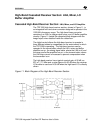
SWRA004A
40 TRF1500 Integrated Dual-Band RF Receiver User’s Guide
High-Band Cascaded Test Guide
This section involves measuring the cascaded performance of the
High Band LNA, High Band Mixer and High Band IF Amp using
the Frequency Doubler. All tests apply for an IF output terminated
into a 1 k
Ω
differential load. A transformer balun is used to match
the IF output to the 50
Ω
test equipment. All unused ports are
terminated into 50
Ω
.
Table 4. HB LNA, HB mixer, HB IF amp
PARAMETERS Min Typ Max UNIT
RF Input Frequency Range 1930 1960 1990 MHz
Direct Drive LO Frequency Range 2040.52 2070.52 2100.52 MHz
Doubler Drive LO Frequency Range 1020.26 1035.26 1050.26 MHz
IF Frequency 110.52 MHz
RF Input Power -30 dBm
LO Input Power -5 dBm
Power Conversion Gain 26.3 dB
Power Conversion Gain Reduction 43.5 dB
Image Rejection 22.5 dB
Noise Figure 4.66 dB
RF Input Return Loss 14.2 dB
LO Buffer Output Power -14 dBm
Power Leakage LO In to RF In -50 dBm
Third Order Input Intercept Point(IIP3) -17.7 dBm
1dB RF Input Compression Point -23.7 dBm
2X2 Spur Performance 69 dBc
3X3 Spur Performance 81 dBc
High-Band Cascaded: Power Conversion Gain
Control state: 111001
SEE APPENDIX A: TEST BENCH SETUPS
Test setup Figure 20
The high band power conversion gain (dB) is the measured power
(dBm) at the IF frequency minus the RF source power (dBm). It is
measured using a RF source and a spectrum analyzer.
1) Set the RF source power (RF P
in
) and the desired frequency
(see Table 4). Connect the RF source to the EVM RF port,
J20.


















